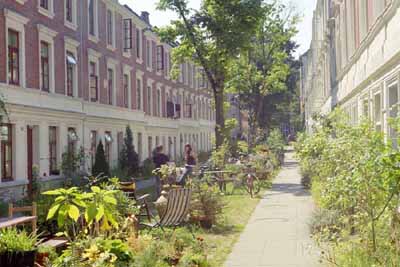 |
Home
About Us
Join Us
Support us
Contacts
Our Projects
Resource Centre
E-Bulletin
Discussion Lists
Conferences and Seminars
World Carfree Day
Calendar
Green Pages
Press
Links

|
 |
 |
Carfree Area Pilot Projects

"Falkenried Terraces", Hamburg, 2005, © M. Heller, www.autofrei-wohnen.de
Increasing urban sprawl causes severe problems related to the challenges mankind is facing. Prominent among these is the rising dependence on car traffic in all cities of the world, although the majority of the world population still lives without a car (even in European cities up to 50 % of households live carfree). The consequences of this trend are a significant contribution of car traffic to climate change, depletion of energy resources, air pollution and a decreasing quality of life.
The Carfreearea project is aiming to meet these challenges by designing urban areas, where car traffic is reduced to an absolute minimum (mostly for emergency and public services related transport needs, using appropriate vehicles), promoting less car-dependent lifestyles and creating benefits for all people living without a car. It focuses on real estate development based on sustainable transport, i.e. on the planning of infrastructure (predominantly) for pedestrians (and other non-motorised means of transport) and public transport, supported by the necessary density and mix of land uses.
The project will provide examples for the main approaches towards developing Carfree Areas:
• New urban development on brownfield (preferred) or greenfield sites, allowing the design of appropriate new urban patterns and the related transport system;
• Transforming an existing neighbourhood (concerning the much larger share of building stock) by adapting urban patterns and the transport system.
In this project Carfree Area implies:
• that an appropriate design of urban structures for pedestrians, cyclists and public transport ensures accessibility without the need for and presence of private cars;
• that driving and parking private cars within the area is not permitted and household car ownership should be significantly reduced;
Benefits of a Carfree Area
A Carfree Area offers reduced air and noise pollution and a lower risk of injuries by traffic accidents. There is more space for people in an attractive, quiet, safe and healthy environment, promoting a slower-paced, more relaxed, healthier and thus more sustainable lifestyle. This allows more personal interaction with neighbours resulting also in the presence of more people in public areas during day and night thus creating a greater sense of community. And such developments contribute to diversify the housing market, giving people more choices about how they want to live.
Project coordinatior:
Prof. Günter Emberger (Vienna University of Technology)
Contacts:
Franz Skala, Institute of Ecological Urban Development, A-Vienna
Simon Field, Carfree UK, UK-Brighton
E-mail:
|
|
![[Home]](http://worldcarfree.net/img/logo1.jpg)




![[Home]](http://worldcarfree.net/img/logo1.jpg)






